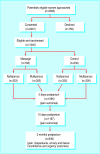Perineal massage in labour and prevention of perineal trauma: randomised controlled trial
- PMID: 11375230
- PMCID: PMC31922
- DOI: 10.1136/bmj.322.7297.1277
Perineal massage in labour and prevention of perineal trauma: randomised controlled trial
Abstract
Objective: To determine the effects of perineal massage in the second stage of labour on perineal outcomes.
Design: Randomised controlled trial.
Participants: At 36 weeks' gestation, women expecting normal birth of a singleton were asked to join the study. Women became eligible to be randomised in labour if they progressed to full dilatation of the cervix or 8 cm or more if nulliparous or 5 cm or more if multiparous. 1340 were randomised into the trial.
Intervention: Massage and stretching of the perineum during the second stage of labour with a water soluble lubricant.
Primary outcomes: rates of intact perineum, episiotomies, and first, second, third, and fourth degree tears.
Secondary outcomes: pain at three and 10 days postpartum and pain, dyspareunia, resumption of sexual intercourse, and urinary and faecal incontinence and urgency three months postpartum.
Results: Rates of intact perineums, first and second degree tears, and episiotomies were similar in the massage and the control groups. There were fewer third degree tears in the massage group (12 (1.7%) v 23 (3.6%); absolute risk 2.11, relative risk 0.45; 95% confidence interval 0.23 to 0.93, P<0.04), though the trial was underpowered to measure this rarer outcome. Groups did not differ in any of the secondary outcomes at the three assessment points.
Conclusions: The practice of perineal massage in labour does not increase the likelihood of an intact perineum or reduce the risk of pain, dyspareunia, or urinary and faecal problems.
Comment in
-
Perineal massage in pregnancy. Such massage significantly decreases perineal trauma at birth.BMJ. 2001 Sep 29;323(7315):753-4. BMJ. 2001. PMID: 11675731 Free PMC article. Clinical Trial. No abstract available.
-
Perineal massage in pregnancy. True incidence of third degree tears should be ascertained.BMJ. 2001 Sep 29;323(7315):754. BMJ. 2001. PMID: 11675732 No abstract available.
References
-
- Johanson R. Perineal massage for prevention of perineal trauma in childbirth. Lancet. 2000;355:250–251. - PubMed
-
- Klein MC, Gauthier RJ, Robbins JM, Kaczorowski J, Jorgensen SH, Franco ED, et al. Relationship of episiotomy to perineal trauma and morbidity, sexual dysfunction and pelvic floor relaxation. Am J Obstet Gynecol. 1994;71:591–598. - PubMed
-
- Myles MF. A textbook for midwives. Edinburgh: Livingstone; 1953. pp. 304–305.
-
- Sleep J. Physiology and management of the second stage of labour. In: Bennett VR, Brown LK, editors. Myles textbook for midwives. London: Churchill Livingstone; 1993. pp. 199–215.
-
- Kitzinger S, Simkin P. Episiotomy and the second stage of labour. Seattle: Pennypress; 1984.
Publication types
MeSH terms
LinkOut - more resources
Full Text Sources
Other Literature Sources
Medical

